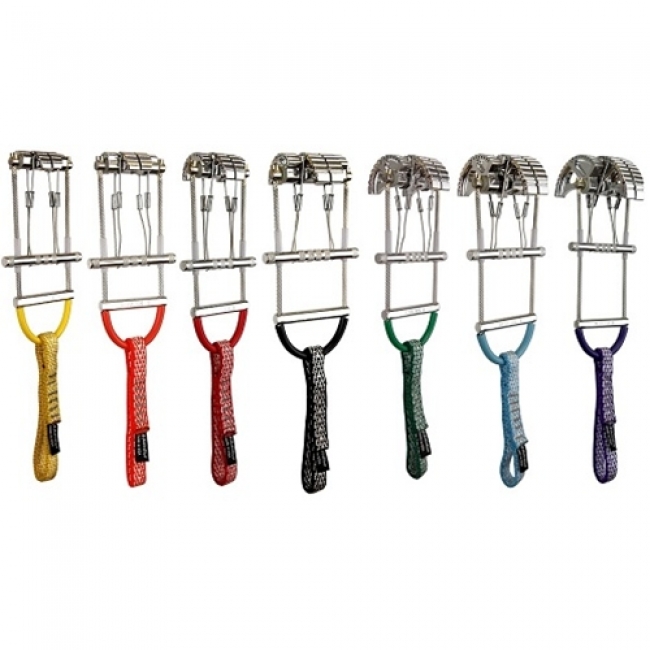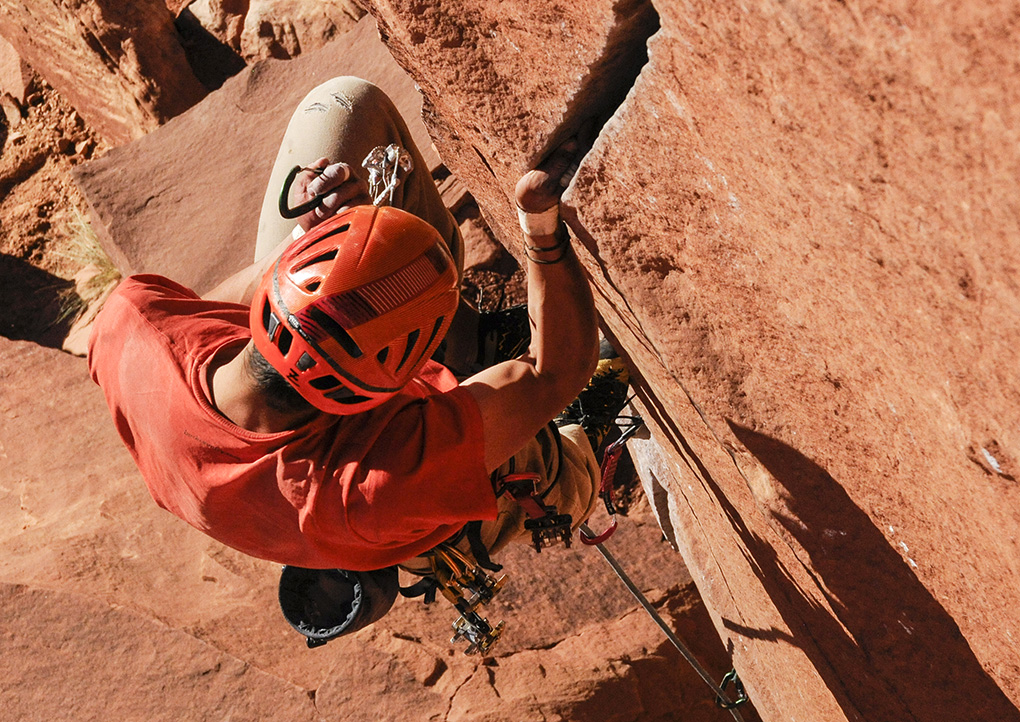Metolius Fat Cam
Features:

- Direct Axle Technology™ (DAT™) makes Ultralight Fat Cams up to 20% lighter
- DAT allows for more placement options in shallow, narrow, or bottoming placements
- DAT makes tricky placements easier due to better cam lobe visibility, especially in the small sizes
- 13 mm (0.51″) Monster Sling webbing
- Optimized cam angle for increased holding power
- Widest cam faces available for maximum grip
- Machined cam stops
- Color-coded sewn slings and tubing
- CNC machined
- 6061-T6 aluminum
- Hand built, inspected and individually proof tested in Bend, Oregon
Sizes Tested: 3 (orange), 5 (black), 6 (green)
MSRP: $70
Days Tested: 30+
Locations Tested: Castleton Tower, Indian Creek, and Big Cottonwood Canyon, Utah
In a world where climbing manufacturers constantly tout narrow head width (see BD X4’s, Metolius Mastercams, and the continued popularity of Aliens) and expansion range, the Metolius Fat Cams buck convention in multiple ways:
A fatter cam lobe? Relatively small range even in larger sizes? Shorter, stiffer stem? Comparable to other cams, the Fat Cams are relatively harder to place and harder to clean. What is Metolius thinking?
The Holy Mecca of crack climbing, a wild and beautiful place known as Indian Creek. That’s what Metolius is thinking.
Design
The Fat Cams look strikingly similar to other Metolius cams (Mastercams excluded). Users of TCU’s and Powercams will feel right at home with the familiar U-stem design. The Fat Cam is a four lobe, single axle design, with lobes set between the U-stem. The cam angle is identical to all other Metolius cams as well at 13.25 degrees.
As a slight tangent, I really appreciate the consistency between Metolius cams, as they all place the same. Because Metolius keeps their cam sizing consistent across their various lines (Supercams excepted), climbers who are familiar with TCUs or Mastercams will find they have to make little or no adjustment to placing fat cams
Stem
The stem on the Fat Cams is relatively shorter and stiffer than the Mastercams or even C4’s. A shorter stem makes a cam both harder to place and remove in deep placements, since you need to reach further back into the crack to retract the trigger. A stiffer stem generally leads to more walking due to greater transmission of rotational force to the cam and potential levering of a cam out of a crack. I did not experience as much walking with the Fat Cams, however.

A wider base of contact due to the fatter lobes spreads out rotational force as a cam tries to walk, resulting in less movement overall. This is why TCU’s walk more due to only having three points of contact, or why it’s better to place 4CU’s (like C4’s or Mastercams) with the wide lobes down in horizontal placements.
Cam Angle
As Blister’s Dave Alie explained in his Cams 101 piece, there is an inverse relationship between holding power and expansion range depending on cam angle. Metolius’ decision to use a relatively small 13.25 degree angle means their cams theoretically have greater holding power, but suffer from an inherently smaller range than competitors with a larger cam angle. In practice, a properly placed cam will hold a fall regardless of the cam angle, period. But what about the expansion range?
Range
In practice, the reduced expansion range resulting from the smaller cam angle is more noticeable than the increased holding power, especially in the larger sized Fat Cams. I have used extensively the purple, blue, yellow, and orange sizes in Metolius TCU’s and Mastercams (that’s the 0, 1, 2, and 3 for the numerically inclined) over the past two years, and rarely notice a significant difference when placing them as opposed to equivalent sized Black Diamond C4s, a cam with greater expansion range. In the smaller cams, the smaller expansion range is less noticeable because the range itself is smaller even though the percent difference is greater.
In the larger Fat Cam sizes though, I definitely had a harder time adjusting to the smaller range as compared to C4s. I almost got the black and green (that’s the 5 and 6) stuck multiple times as a result of assuming they’d fit the same size crack as I am used to protecting with C4s. The greater range on C4s simply allows for more placement options and makes cleaning cams easier.
*note: I have only included the three sizes of Fat Cams that I tested, and the nearest equivalent C4 size. Fat Cams come in seven sizes, 2-8.
Across sizes, C4s have at least 50% more usable expansion range than Fat Cams.
NEXT: Head Width, Best Use, Etc.


I’m sure these have their uses, but it’s pretty hard to beat a wider expansion range in most cases…especially when you are nearing your limit.
It seems to me that is there is an *actual danger* of climbing areas being shut down because of rock erosion (which hasn’t happened in Yosemite, where many climbs only go free because of pin scars and so on), there is a clear, obvious answer. That answer is called TOP-ROPING. You cannot legislate *every climber* to use these, and they still aren’t gonna 100% reduce it anyways, so this is a pretty weak argument.
Sure, for the rich folks out there, why not have all the toys, a $6000 rack, to go with your 5-figure bike, your 6-figure car, your $1800 tent, and so on….. but most climbers I’ve ever known barely have doubles in the common sizes as it is….
Hi Alvin,
Thanks for the feedback.
I must admit I’m a little confused by your argument. At no point in the review did I suggest legislating the use of Fat Cams, I only suggested their practicality in specific situations. As to your example of Yosemite pin scars, climbers did actually lead the way in reducing rock damage by shifting away from pitons and towards clean climbing (see the 1972 Chouinard catalog), so the shift in protection that Fat Cams represent is not unprecedented. I don’t see a danger of the climbing in Indian Creek getting shut down because of bureaucratic reasons due to rock damage; I do however see a danger in climbs at the Creek changing drastically in character because of rock damage. For me, it’s about more than just, “can we climb here,” it’s about, “can we climb here in such a way as to make the experience the same for the next generation?”
I would argue that most climbers have a rack tailored to their favorite climbing area, for example you’d be hard-pressed to find a dedicated Yosemite climber who doesn’t use off-set cams, or a North Carolina climber who doesn’t use Tri-Cams. So I don’t think it’s unreasonable to advocate (not legislate) for dedicated desert climbers to utilize Fat Cams in specific situations.
Cheers,
Matt